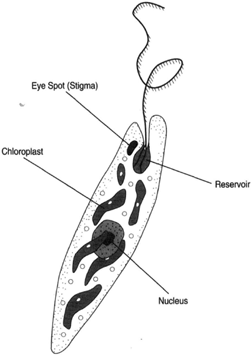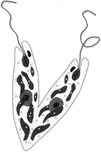Euglenophyta
Students of botany as well as those of zoology often are required to study the organisms of Euglenophyta because these organisms possess both animal and plant characteristics. These organisms are currently(if temporarily) considered part of the Protista kingdom. Yet, they are still called algae. Then umber of Euglenophyta species is estimated to range from 450 to 800. |
| Figure 16-3 Euglena Eye spot (stigma), reservoir, nucleus, and chloroplast. |
A classic example of the group is Euglena, a single-celled, flagellated, generally green (although several forms are colorless, and one form is red) organism lacking a rigid cell wall. The pigments are chlorophyll a, chlorophyll b (as in green algae and flowering plants), and carotenes. They store not starch starchlike product, paramylum, and oil droplets. Rather than a cell wall, is a plasma membrane, just beneath which are fine, parallel strips that spiral around the cell. These structures are collectively referred to as the pellicle. Cellulose is not produced.
At the anterior end is a gullet leading to a reservoir. Near the reservoir is an eye spot; at the base of the reservoir is a contractile vacuole. Arising from the base of the reservoir are two flagella, one of which is so short that it remains within the reservoir (and long escaped detection). The other flagelis lum is long and has numerous tiny hairs along one side. It is used in propulsion. When Euglena divides, the process is by longitudinal fission; no sexual process occurs.
Euglena possesses several chloroplasts and a centrally placed nucleus. These organisms are plantlike in that they carry on photosynthesis. They are also, however, able to thrive in the dark, if suitable nutrients are provided in the water. A good recipe for a medium in which to grow Euglena in the laboratory calls for boiling an extract of horse manure. In certain conditions, Euglena is observed to divide more rapidly than do its chloroplasts and, thus, it becomes
 |
| Figure 16-4 Euglena divides by longitudinal fission. |
colorless. Such colorless forms are able to survive and reproduce if provided with suitable nutrients. Dr. Knut Norstog' notes that photosynthetic forms of Euglena can be converted to colorless forms by treatment with streptomycin, ultraviolet light, or heat. Dr. Arthur Cronquist' asserts that Euglena manufactures the essential amino acid lysine using the same pathway as is noted in fungi.




